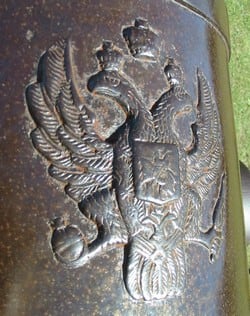Standing on Cannon Triangle in Centennial Park, overlooking Centennial Parklands Dining, are two Russian cannon. The guns flank the We Won Statue, and have been in the Park since 1920. How on earth did they come to be in Centennial Park?
In July 2011, Centennial Park’s good friend and renowned Australian journalist, the late Peter Harvey, was filming a news segment in the Park next to the cannon. He mused for a while about the Crimean War-origins of these weapons, and wondered aloud whether or not they could have actually been present at one of that war’s most well-known moments – the ill-fated Charge of the Light Brigade.
We were determined to find out what we could, and set to work putting together the history of the cannon. Unfortunately our friend Peter passed away before we could finish this work. Here is what we found.
One of the Russian Cannon in Centennial Park – they underwent an interesting journey to end up here!
First, a little bit of history for context…
The Crimean War (1853 – 1856) was a conflict between the Russian Empire and an alliance of the French Empire, the British Empire, the Ottoman Empire, and the Kingdom of Sardinia. Most of the conflict took place on the Crimean peninsula.
The war was not only considered one of the first examples of modern warfare in the world (where technological changes began to influence battlefield outcomes), but is equally well-known for being famous for the work of the pioneering Florence Nightingale, as well as the ill-fated Charge of the Light Brigade (immortalised in poetry by Lord Alfred Tennyson).
As a quirky historical side point, the Crimean War was also the inspiration for the completion of Fort Denison in Sydney Harbour! While work on the fort began in 1841 as a defence against foreign attack construction stalled for a time, however the Crimean War and fear of a Russian invasion as a result of this conflict spurred on the NSW Government to complete the fort’s construction!
The origin of the Centennial Park cannon…

They feature the Russian Tsar’s insignia
The cannon in Centennial Park are SBML 36 Pounders on Iron Garrison Carriage (reference).
What this means is that the weight of projectiles (i.e. cannon balls) from this size cannon is 36 pounds, or 16.3 kg!
Both were cast under the direction of Butenev at the Alexandrovski foundry established in Petrozavodsk, Russia (this factory interestingly had a Scottish link – read about that here).
They carry the double eagle of the Russian Tsar and are stamped with the initials `M.A.’ – the translation of which is Morskaya Artilleria (meaning naval artillery). It is thus concluded that the cannon were originally made for the Russian Navy.
But how did the cannon get from a Russian conflict to an Australian park?
In the defence of Sevastopol in 1854 and 1855 the Russians scuttled eight major warships to protect the harbour. Nearly 700 ships cannon from these warships were removed and became additional artillery located in defensive redoubts around Sevastopol.
In early 1855, after a protracted siege and series of battles, the British and French forces finally overcame the Russian defenders at Sevastopol. The outcome of this battle contributed substantially to the Russians ultimate defeat in the Crimean War.
Over 4,000 artillery pieces were captured in the fall of Sevastopol. In celebration of the victory it was decided to distribute a pair of cannons seized at Sevastopol to each of the most important cities in the British Empire (reference).
In Australia, records show that such ‘trophies of war’ were sent to NSW, Victoria, South Australia, and Tasmania – each receiving two Russian guns in recognition of the funds donated to the Patriotic Fund designated to assist the war effort (reference).
The two cannon that now feature in Centennial Park were originally positioned flanking Governor Bourke’s statue in The Domain in Sydney (near the old Bent Street entrance). They were relocated in 1920 to Centennial Park and mounted on a rise, the trophies now flank the “We Won” statue.
However, all was not perfect at the time. It appears, from the below article from the Sydney Morning Herald of 21 June 1927, that the cannon were in disrepair and simply dumped in Centennial Park during a dispute between Government Departments about who would pay for the transport and restoration!
Article sourced from National Library of Australia – Trove (appeared in the Sydney Morning Herald – 21 June 1927)
Eventually the cannon were pieced together on display where they sat until the 1990s when further restoration work was undertaken on the cannon as part of the Centennial Parklands Stonework Maintenance Program.
What a small inter-connected world we live in!
The ‘We Won’ statue has a cannon on either side